Softening–Melting Properties and Slag Evolution of Vanadium Titano-Magnetite Sinter in Hydrogen-Rich Gases
Abstract
1. Introduction
2. Materials and Methods
2.1. Materials
2.2. Methods
3. Results and Discussion
3.1. Softening–Melting Properties
3.2. Gas Permeability under Different Atmosphere
3.3. Phase Transformation of VTM Sinter during the Softening–Melting Procedure
3.4. Slag Evolution during the Softening–Melting Process
4. Conclusions
Author Contributions
Funding
Institutional Review Board Statement
Informed Consent Statement
Data Availability Statement
Conflicts of Interest
References
- Pang, Z.D.; Lv, X.W.; Jiang, Y.Y.; Ling, J.W.; Yan, Z.M. Blast furnace ironmaking process with super-high TiO2 in the slag: Viscosity and melting properties of the slag. Metal. Mater. Trans. B Process Metall. Mater. Process Sci. 2020, 51, 722–731. [Google Scholar] [CrossRef]
- Cheng, G.J.; Liu, J.X.; Liu, Z.G.; Chu, M.S.; Xue, X.X. Non-isothermal reduction mechanism and kinetics of high chromium vanadium–titanium magnetite pellets. Ironmak. Steelmak. 2014, 42, 17–26. [Google Scholar] [CrossRef]
- Sui, Y.L.; Guo, Y.F.; Jiang, T.; Qiu, G.Z. Separation and recovery of iron and titanium from oxidized vanadium titano-magnetite by gas-based reduction roasting and magnetic separation. J. Mater. Res. Technol. 2019, 8, 3036–3043. [Google Scholar] [CrossRef]
- Guo, X.F.; Dai, S.J.; Wang, Q.Q. Influence of different comminution flowsheets on the separation of vanadium titano-magnetite. Miner. Eng. 2020, 149, 106268. [Google Scholar] [CrossRef]
- Zhao, W.; Chu, M.S.; Wang, H.T.; Liu, Z.G.; Tang, J.; Ying, Z.W. Reduction behavior of vanadium-titanium magnetite carbon composite hot briquette in blast furnace process. Powder Technol. 2018, 342, 214–223. [Google Scholar] [CrossRef]
- Chen, W.B.; Dong, Z.Q.; Jiao, Y.; Liu, L.L.; Wang, X.D. Preparation, sintering behavior and consolidation mechanism of vanadium–titanium magnetite pellets. Crystals 2021, 11, 188. [Google Scholar] [CrossRef]
- Gan, M.; Sun, Y.F.; Fan, X.H.; Ji, Z.Y.; Lv, W.; Chen, X.L.; Jiang, T. Preparing high-quality vanadium titano-magnetite pellets for large–scale blast furnaces as ironmaking burden. Ironmak. Steelmak. 2020, 47, 130–137. [Google Scholar] [CrossRef]
- Xiang, J.Y.; Wang, X.; Yang, M.R.; Wang, J.; Shan, C.; Fan, G.Q.; Qiu, G.B.; Lv, X.W. Slag–foaming phenomenon originating from reaction of titanium-bearing blast furnace slag: Continuous monitoring of foaming height and calibration. J. Mater. Res. Technol. 2021, 11, 1184–1192. [Google Scholar] [CrossRef]
- Fu, W.G.; Xie, H.E. Progress in technology of vanadium–bearing titanomagnetite smelting in Pangang. Steel Res. Int. 2011, 82, 501–504. [Google Scholar] [CrossRef]
- Tang, J.; Chu, M.S.; Li, F.; Feng, C.; Liu, Z.G.; Zhou, Y.S. Development and progress on hydrogen metallurgy. Int. J. Min. Met. Mater. 2019, 27, 713–723. [Google Scholar] [CrossRef]
- Zhang, S.H.; Yi, B.W.; Guo, F.; Zhu, P.Y. Exploring selected pathways to low and zero CO2 emissions in China’s iron and steel industry and their impacts on resources and energy. J. Clean. Prod. 2022, 340, 130813. [Google Scholar] [CrossRef]
- Gao, X.D.; Zhang, R.; You, Z.X.; Yu, W.Z.; Dang, J.; Bai, C.G. Use of hydrogen-rich gas in blast furnace ironmaking of V-bearing titanomagnetite: Mass and energy balance calculations. Materials 2022, 15, 6078. [Google Scholar] [CrossRef] [PubMed]
- Yang, G.Q.; Zhang, J.L.; Chen, Y.X.; Wu, Q.Y.; Zhao, Z.Y.; Zhao, J. Influence of hydrogen content of bosh gas on softening–melting property of iron–bearing burden material. Iron Steel 2012, 47, 14–18. [Google Scholar] [CrossRef]
- Pistorius, P.C.; Gibson, J.; Jampani, M. Natural gas utilization in blast furnace ironmaking: Tuyere injection, shaft injection and prereduction. In Applications of Process Engineering Principles in Materials Processing, Energy and Environmental Technologies; Springer: Cham, Switzerland, 2017; pp. 283–292. [Google Scholar]
- Jampani, M.; Gibson, J.; Pistorius, P.C. Increased use of natural gas in blast furnace ironmaking: Mass and energy balance calculations. Metal. Mater. Trans. B Process Metall. Mater. Process Sci. 2019, 50, 1290–1299. [Google Scholar] [CrossRef]
- Qie, Y.N.; Lyu, Q.; Liu, X.J.; Li, J.P.; Lan, C.C.; Zhang, S.H.; Yan, C.J. Effect of hydrogen addition on softening and melting reduction behaviors of ferrous burden in gas–injection blast furnace. Metal. Mater. Trans. B Process Metall. Mater. Process Sci. 2018, 49, 2622–2632. [Google Scholar] [CrossRef]
- Babich, A.; Yaroshevskii, S.; Formoso, A. Co-injection of noncoking coal and natural gas in blast furnace. Trans. Iron Steel Inst. Jpn. 2007, 39, 229–238. [Google Scholar] [CrossRef]
- Yu, J.W.; Hu, N.; Xiao, H.X.; Gao, P.; Sun, Y.S. Reduction behaviors of vanadium-titanium magnetite with H2 via a fluidized bed. Powder Technol. 2021, 385, 83–91. [Google Scholar] [CrossRef]
- Sui, Y.L.; Guo, Y.F.; Jiang, T.; Xie, X.L.; Wang, S.; Zheng, F.Q. Gas-based reduction of vanadium titano-magnetite concentrate: Behavior and mechanisms. Int. J. Miner. Metall. Mater. 2017, 24, 10–17. [Google Scholar] [CrossRef]
- Zhou, K.; Song, J.Q.; You, Z.X.; Xie, H.E.; Lv, X.W. Softening–melting properties and slag evolution behavior of high titanium sinter. ISIJ Int. 2020, 60, 1409–1415. [Google Scholar] [CrossRef]
- Hu, Q.Q.; Ma, D.L.; Zhou, K.; Liu, Y.J.; You, Y.; You, Z.X.; Lv, X.W. Phase transformation and slag evolution of vanadium–titanium magnetite pellets during softening–melting process. Powder Technol. 2022, 396, 710–717. [Google Scholar] [CrossRef]
- Yin, C.; Zhang, S.F.; Yang, X.K.; Yuan, W.N.; Yu, W.Z.; Wen, L.Y.; Li, T.; Bai, C.G. Smelting vanadium–titanium magnetite by COREX process: Effect of V–Ti bearing pellet ratio on the softening and melting behavior of mixed burden. Metall. Mater. Trans. B Process Metall. Mater. Process Sci. 2021, 52B, 4096–4108. [Google Scholar] [CrossRef]
- Standardization Administration of China. Iron Ores—Method for Determination of Iron Reduction Softening Drippinger Performance under Load. Available online: https://c.gb688.cn/bzgk/gb/showGb?type=online&hcno=94D8E7D936DCB10202AEAF3473FD85FC2017 (accessed on 19 January 2023).
- Du, H.G. Reduction procedure of vanadium titano-magnetite. In Principle of Smelting Vanadium Titano-Magnetite in Blast Furnace; Science Press: Beijing, China, 1996; pp. 127–131. [Google Scholar]
- Chen, J.W.; Jiao, Y.; Wang, X.D. Thermodynamic studies on gas-based reduction of vanadium titano-magnetite pellets. Int. J. Min. Met. Mater. 2019, 26, 822–830. [Google Scholar] [CrossRef]
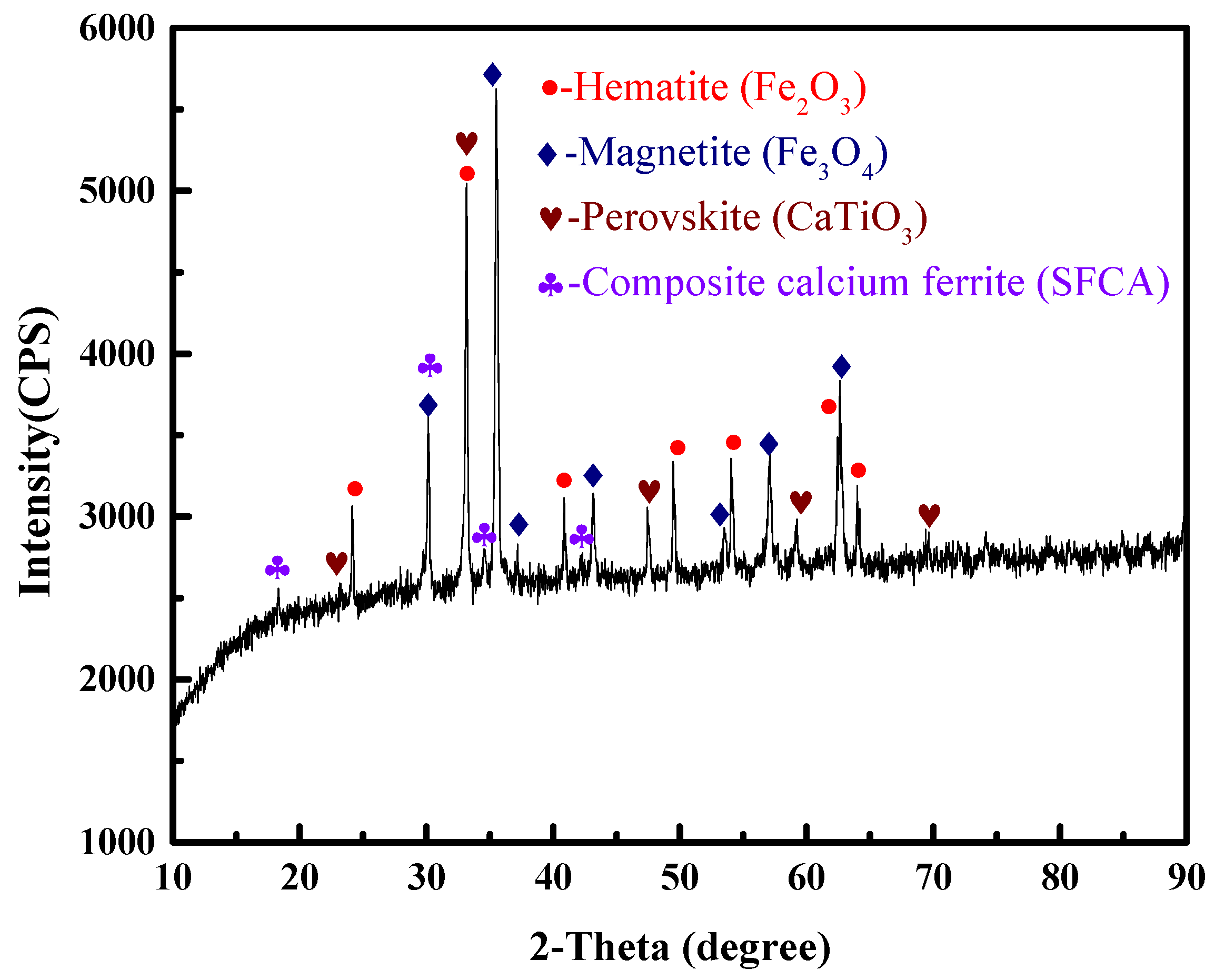

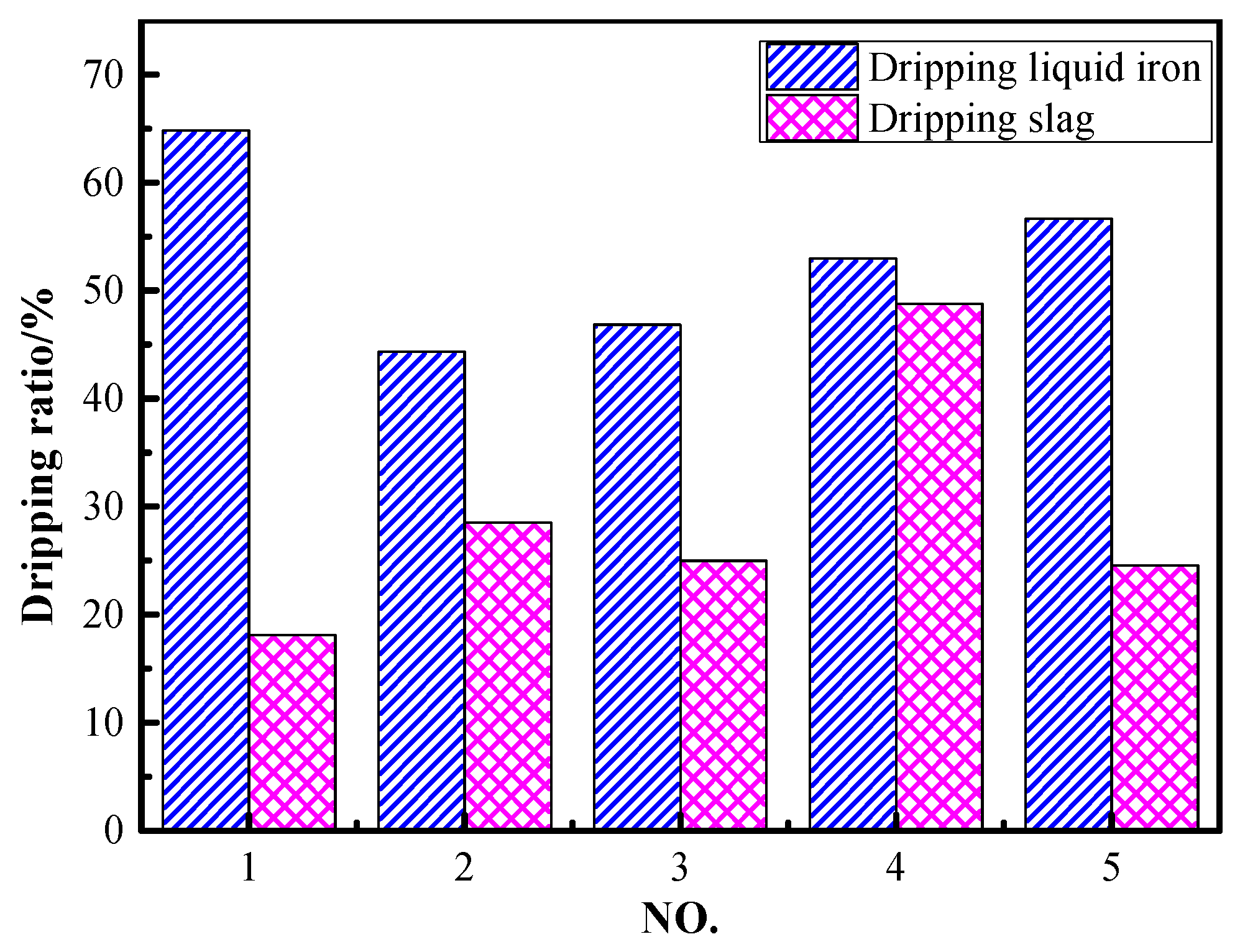
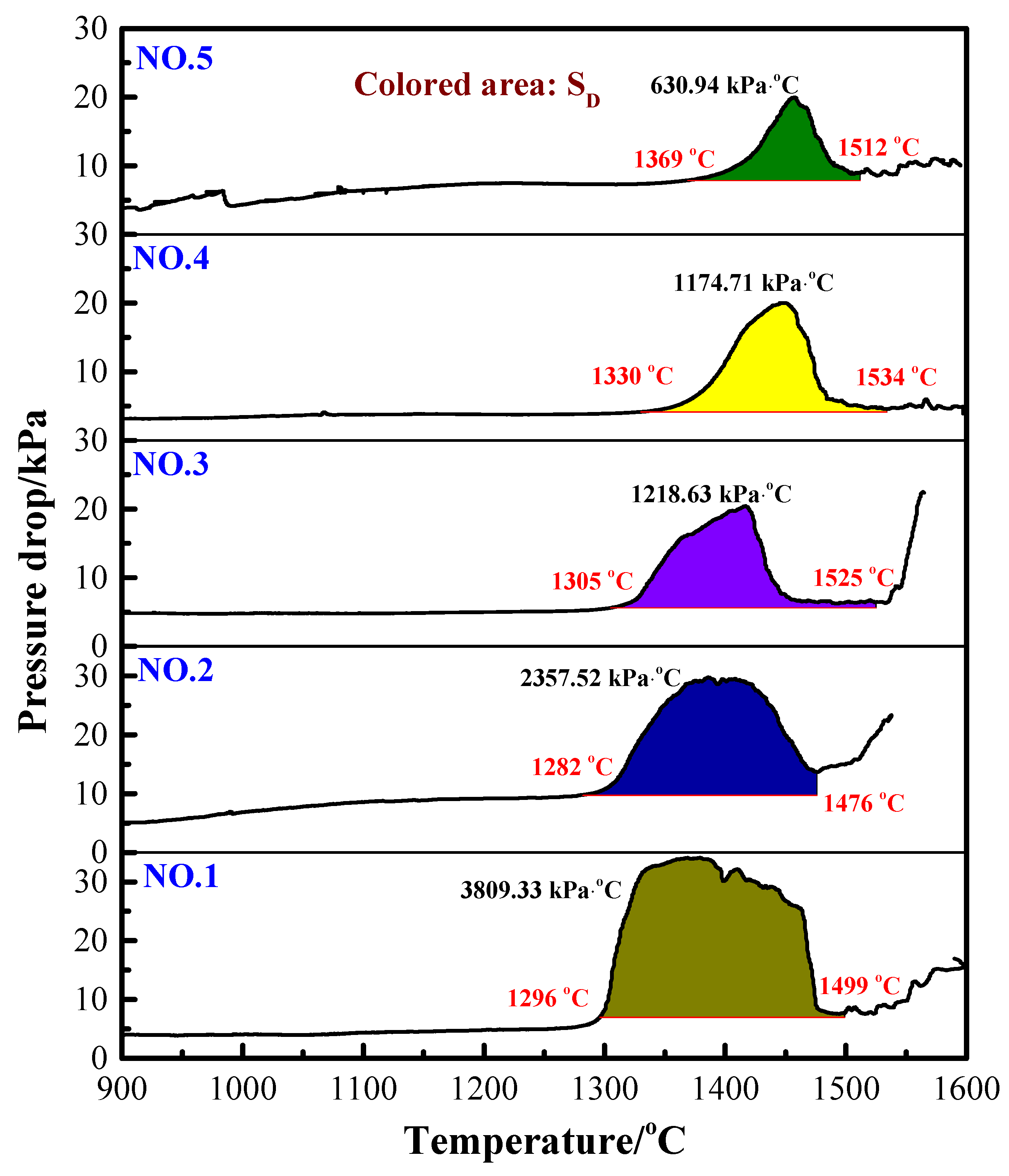
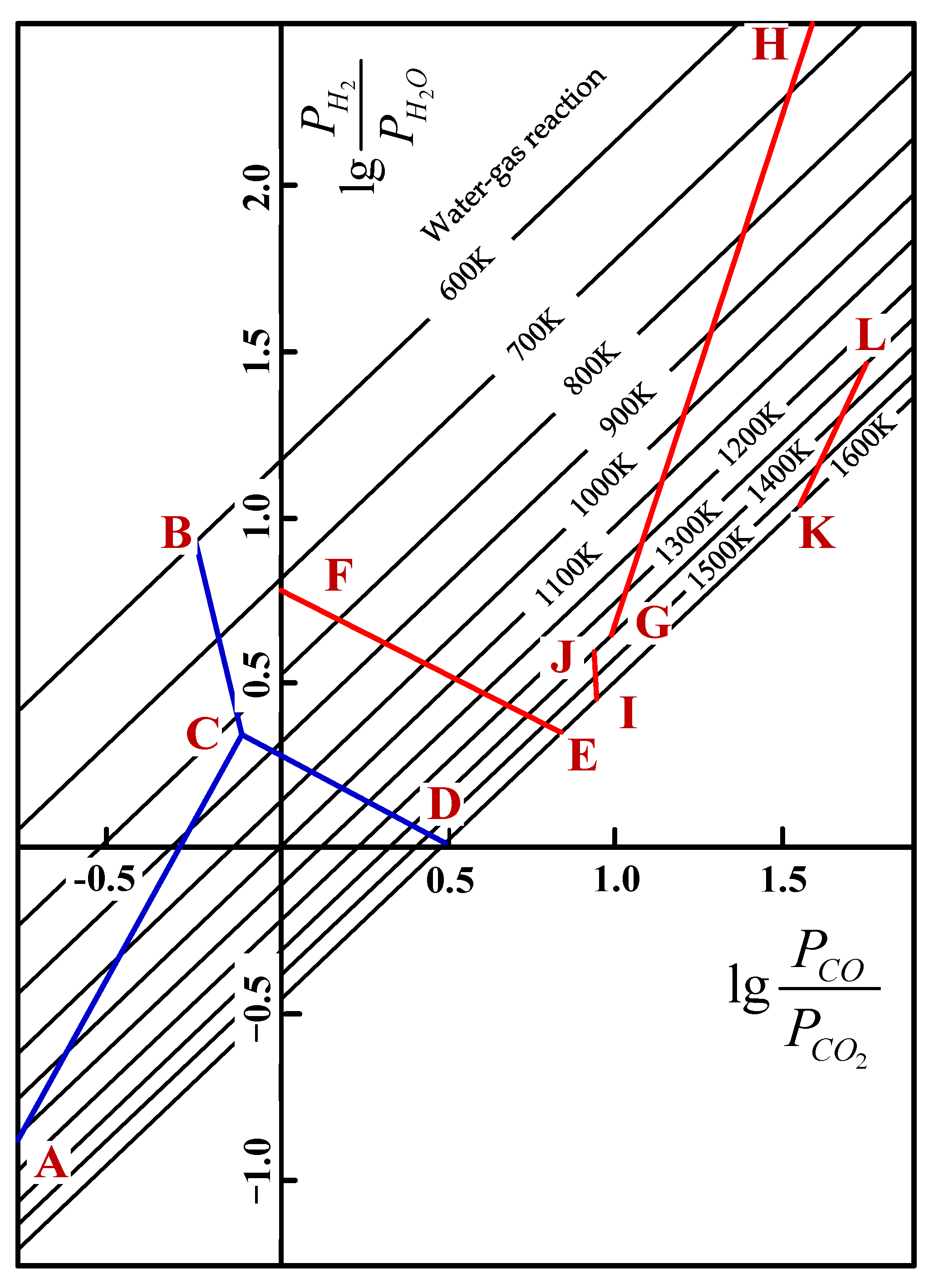
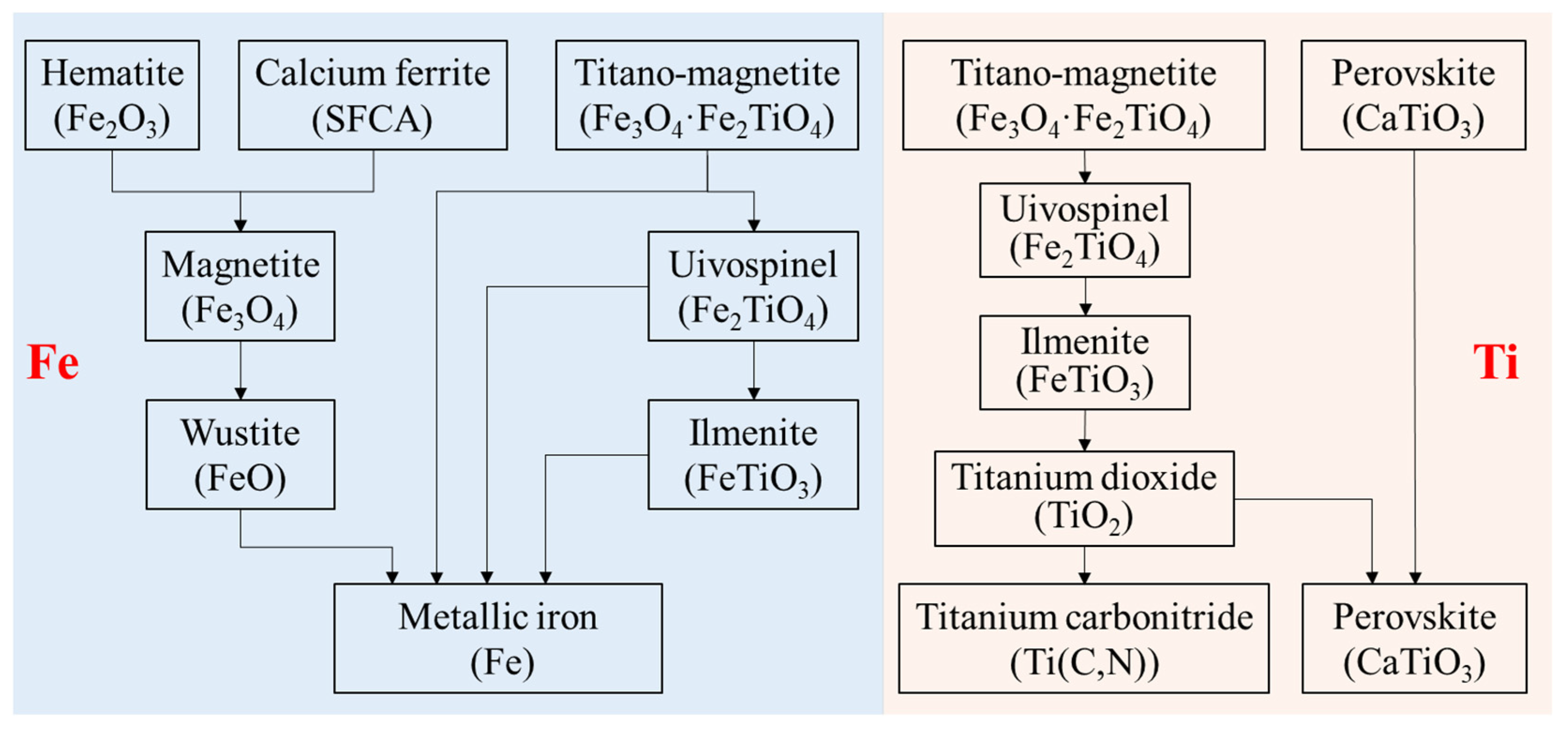

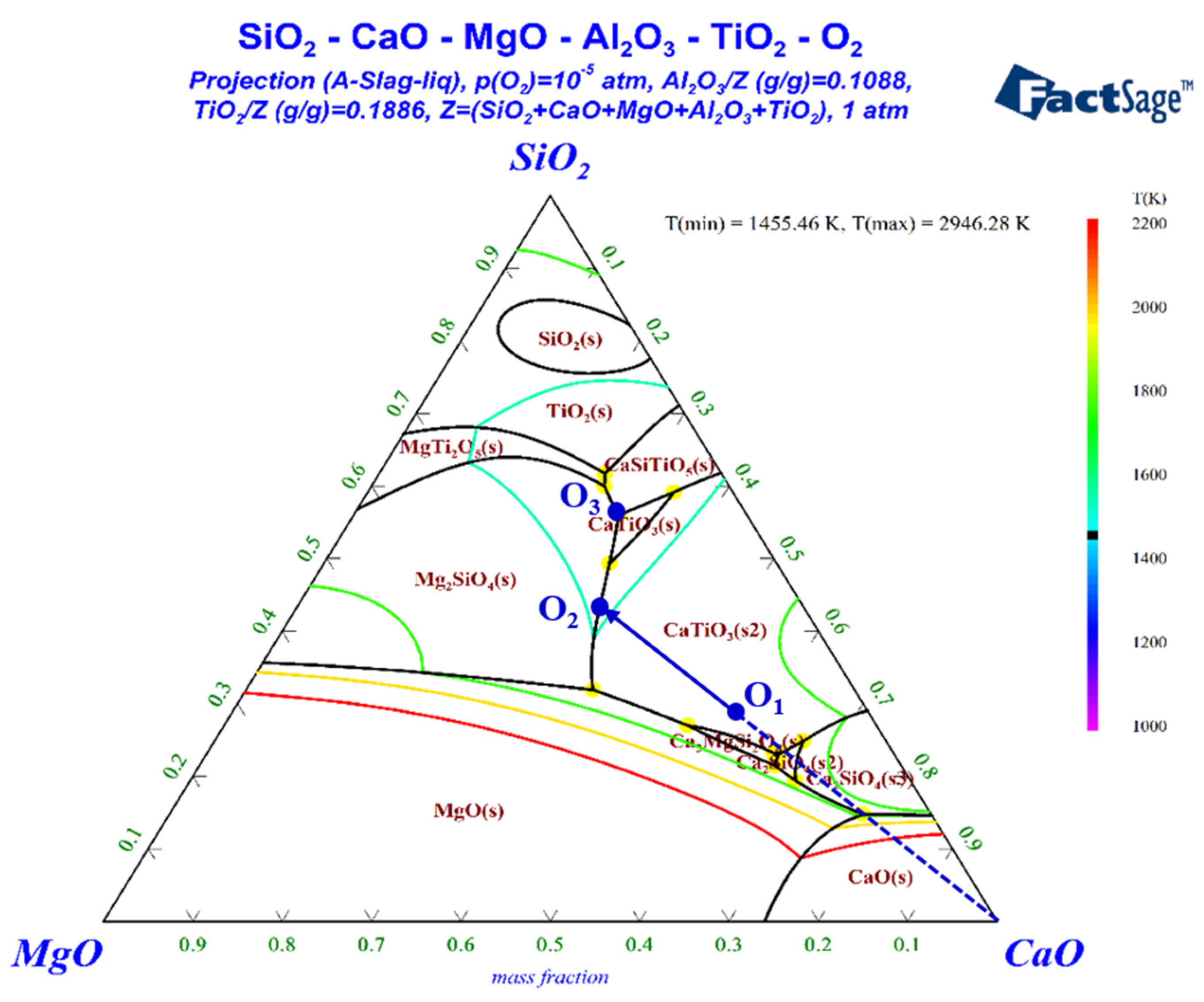
| TFe | FeO | SiO2 | MgO | Al2O3 | TiO2 | CaO | V2O5 | R2 |
|---|---|---|---|---|---|---|---|---|
| 50.72 | 7.61 | 5.58 | 2.98 | 3.04 | 5.27 | 11.08 | 0.38 | 1.99 |
| NO. | CO | H2 | N2 |
|---|---|---|---|
| 1 | 30 | 0 | 70 |
| 2 | 50 | 0 | 50 |
| 3 | 45 | 5 | 50 |
| 4 | 35 | 15 | 50 |
| 5 | 25 | 25 | 50 |
| Parameter | Implication | Parameter | Implication |
|---|---|---|---|
| T10 | Softening onset temperature, °C | ΔT1 | Softening interval, T40-T10, °C |
| T40 | Softening ending temperature, °C | ΔT2 | Melting–dripping interval, Td-Ts, °C |
| Ts | Melting onset temperature, °C | ΔT3 | Soft melting interval, Td-T10, °C |
| Td | Dripping temperature, °C | ΔTd | Dripping interval, Tds-Td, °C |
| Tds | Temperature of burden no longer dripping, °C | SD | Gas permeability index, kPa·°C |
| No. | T10 (°C) | T40 (°C) | △T1 (°C) | TS (°C) | Td (°C) | △T2 (°C) | △T3 (°C) | T△Pm (°C) | △Pm (kPa) |
|---|---|---|---|---|---|---|---|---|---|
| 1 | 1147 | 1252 | 105 | 1296 | 1499 | 203 | 352 | 1369 | 34.11 |
| 2 | 1092 | 1241 | 149 | 1282 | 1476 | 194 | 384 | 1386 | 29.76 |
| 3 | 1081 | 1231 | 150 | 1305 | 1525 | 220 | 444 | 1417 | 20.43 |
| 4 | 1080 | 1251 | 171 | 1330 | 1534 | 204 | 454 | 1443 | 20.02 |
| 5 | 1081 | 1262 | 181 | 1369 | 1512 | 143 | 431 | 1457 | 19.97 |
| Eq. | Reactions |
|---|---|
| AC | Fe3O4 + CO (H2) = 3FeO + CO2(H2O) |
| BC | 1/4Fe3O4 + CO (H2) = 3/4Fe + CO2(H2O) |
| CD | FeO + CO (H2) = Fe + CO2(H2O) |
| EF | Fe2TiO4 + CO (H2) = Fe + FeTiO3 + CO2(H2O) |
| GH | FeTiO3 + CO (H2) = Fe + TiO2 + CO2(H2O) |
| IJ | 2FeTiO3 + CO (H2) = Fe + FeTi2O5 + CO2(H2O) |
| KL | 3/5FeTi2O5 + CO (H2) = 3/5Fe + 2/5Ti3O5 + CO2(H2O) |
Disclaimer/Publisher’s Note: The statements, opinions and data contained in all publications are solely those of the individual author(s) and contributor(s) and not of MDPI and/or the editor(s). MDPI and/or the editor(s) disclaim responsibility for any injury to people or property resulting from any ideas, methods, instructions or products referred to in the content. |
© 2023 by the authors. Licensee MDPI, Basel, Switzerland. This article is an open access article distributed under the terms and conditions of the Creative Commons Attribution (CC BY) license (https://creativecommons.org/licenses/by/4.0/).
Share and Cite
Xin, R.; Zhao, J.; Gao, X.; You, Z.; Yu, W.; Zhang, S.; Dang, J.; Bai, C. Softening–Melting Properties and Slag Evolution of Vanadium Titano-Magnetite Sinter in Hydrogen-Rich Gases. Crystals 2023, 13, 210. https://doi.org/10.3390/cryst13020210
Xin R, Zhao J, Gao X, You Z, Yu W, Zhang S, Dang J, Bai C. Softening–Melting Properties and Slag Evolution of Vanadium Titano-Magnetite Sinter in Hydrogen-Rich Gases. Crystals. 2023; 13(2):210. https://doi.org/10.3390/cryst13020210
Chicago/Turabian StyleXin, Ran, Jianbo Zhao, Xudong Gao, Zhixiong You, Wenzhou Yu, Shengfu Zhang, Jie Dang, and Chenguang Bai. 2023. "Softening–Melting Properties and Slag Evolution of Vanadium Titano-Magnetite Sinter in Hydrogen-Rich Gases" Crystals 13, no. 2: 210. https://doi.org/10.3390/cryst13020210
APA StyleXin, R., Zhao, J., Gao, X., You, Z., Yu, W., Zhang, S., Dang, J., & Bai, C. (2023). Softening–Melting Properties and Slag Evolution of Vanadium Titano-Magnetite Sinter in Hydrogen-Rich Gases. Crystals, 13(2), 210. https://doi.org/10.3390/cryst13020210










